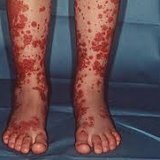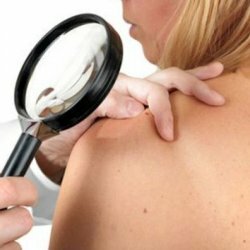Allergic hemorrhagic vasculitis, Shenlaine Henoch's disease

Henoch's disease is an inflammatory disease that affects small vessels of the skin, joints and abdominal cavity. Vascular injury is also accompanied by subcutaneous hemorrhage. Mucous membranes of the wall of the large or small intestine can also be affected, then it manifests itself, in addition to hemorrhage, with ulcers as well. Disease of an allergic nature, most often occurs in small children and adolescents. Pensioners suffer such a disease very rarely. In the category of risk are mainly schoolchildren and preschool children. The statistics reads as follows: fifteen people become ill with 10,000 healthy people. The disease mainly affects the male sex, the peak comes closer to the spring.
Disease allergic vasculitis
Allergic hemorrhagic vasculitis can be caused by other diseases - streptococcal angina, infectious diseases of the respiratory tract, allergy to medicines or food. If you take all the studies and medical statistics, the actual causes of the disease are not fully established. In some cases, Shenlaine-Henoch disease was preceded by viral and β-hemolytic streptococcal infections. And sometimes vasculitis appeared simultaneously with the ingestion of a strong food and drug allergen. There are also well-founded assumptions that heredity also plays a role. This pathology is also transmitted by inheritance.
The capillaries suffer the most from the disease. Characteristic symptoms include hemorrhages, neutrophilic infiltration and the formation of thrombi in the skin, gastrointestinal tract, kidneys and joints.
With progression of the disease, individual immune complexes of appropriate content will cause inflammation with plasma separation in the tissue and hemorrhages. These complications arise from the deposition of immune complexes in small arterioles and mesangia, and also, as mentioned above, also in capillaries.
This disease is accompanied by symptoms such as palpation of purpura on the surface of the hands and feet at the folds, tissues on the buttocks, spasmodic pains in the abdomen, spotting in the urine. Sometimes the cause of excretion can not only hemorrhagic vasculitis, but also other infectious allergic kidney disease - glomerulonephritis.
If you bring together all the symptoms, you will get the following symptoms of Shenlaine Genoch's disease:
- patients may suffer from fever;
- pain in the knee and elbow joints;
- pain and bleeding in the area of the stomach and intestines;
- nephritis;
- local eruptions on the legs and buttocks;
- presence of bloody impurities in the urine;
- in some cases is accompanied by an increase in blood pressure.
The disease is usually transferred once in a lifetime, and after a complete cure of complications is not observed. Sometimes it also happens that there are repeated exacerbations, and as a rule, in a short period of time in two to three years. Exacerbations that reappear are no longer accompanied by many unpleasant symptoms, but only a rash on the legs and buttocks. In a chronic form, this disease is rarely transformed.
The disease manifests itself in only four clinical forms: skin-joint, skin-abdominal, cutaneous-renal and mixed hemorrhagic vasculitis.
According to what area is affected, the symptoms will vary slightly. Allergic hemorrhagic vasculitis, Shenlaine Henoch's disease has such manifestations on the skin integuments( cutaneous clinical form) - symmetrically revealed by petechial rash on the arms, legs, buttocks. The rash is especially pronounced at the onset of the disease. This is due to the fact that the capillaries are systematically affected, their walls become brittle and a small shock or shock is enough to cause a bruise. Now, when they are formed in large quantities and concentrate in a certain area, it means that the disease has become aggravated. It even happens that the petechiae are formed spontaneously.
A few days after the appearance of skin eruptions and bruises may appear articular. In this case, the patient begins to feel pain of varying intensity, both in large and small joints.
Abdominal symptoms are more common in young children, and can be more pronounced than other symptoms. The pains are usually strong and expressed in the form of fights, so you can sometimes confuse with peritonitis.
On the part of the kidneys, the Shenlaine-Henoch disease also manifests itself. Its clinical manifestations can also be confused with other diseases, for example with glomerulonephritis. Because the causative agent is β - hemolytic streptococcus. Kidney symptoms do not appear immediately, not as skin symptoms. And somewhere in half a month after the onset of the disease. By this time, microvessels of the renal glomeruli will be affected. One of the most frequent manifestations will be bloody clots in the urine.
How to diagnose a disease, because not all symptoms can immediately be present, but only a few or even one.
Even in the presence of an inflammatory process, the diagnosis will show that the hemolytic activity of the complement is within normal limits. The IgA level will be higher than normal, and its deposits will be on the skin and in the kidneys.
Treatment of this disease is directed to the repayment of symptoms. If the disease has spread to internal organs and the digestive system, then corticosteroids are prescribed for treatment.
In the treatment of an important role is the adherence to a special diet, which is developed by the doctor. And you can not retreat from it. The diet will be based on the principles of excluding allergens and foods that the patient is not tolerating well. To treat the patient is hospitalized.
At the same time to exclude the development of additional allergic reactions during treatment, antibiotics are not used, as are antihistamines. However, the latter are not prescribed for another reason - they are simply not effective in the fight against allergic hemorrhagic vasculitis.



